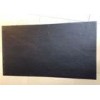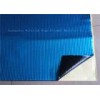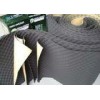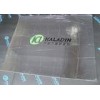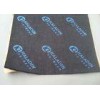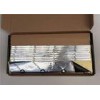One Side Self Adhesive Sound Absorption Panels Low Conductivity Factor
White 20 mm Sound Insulation Cotton Self - Adhesive For Car Noise Reducing
Product Description:
Strong Resilience non-woven fabric sound deadener for car
C15 car sound deadener is produced with the non-combustible, light weight, loose structure and high performance synthetic fiber, with excellent sound absorbing performance.
The non-woven cloth covered on the surface protect the fiber from weathering and increase life span. The internal porous micro fiber can effectively absorb the high frequency noise.
It is widely used in car doors, roof, trunk, engine, chassis, etc.
Advantages of car sound deadening material :
Excellent sound-absorbing performance;
Less sound insulation materials;
Functions:
Release the structure transmission attenuation vibration energy
Reduce the vibration of the resonance frequency
Lessen the vibration of the structure shaking or the striking
Application:
Widely used in construction, automotive, home theater, air conditioning and other electric equipment, also be applied to thecar doors, Roof , floor, deck lids, wheel fender, back trunk , four-wheels and wings board, engine cover or other metal parts , etc
Double side non-woven fabric increase the strength of the sound-absorbing cotton , to protect the molten fiber sound-absorbing material fluff, stable size, enhance appearance.
Easy to paste;
High tech environmental protection;
Strong Resilience ;
And can replac other international products of the same characteristics
Technical data:
| Technical data: | |
|
1. product Model : 2. Thickness: 3. Color: 4. Weight per square meters: 5. Total Weight Per Sheet : 6. Temperature range: 8. Total Dimension 9. LOGO
|
C15 Celsius -40 up to 110° 500mmX800mm(=0.4 M²)/Sheet KALADIN |
Installation :
1. Use scissors, knife or die to cut the mat to the desired size and shape before removing the release liner.
2. Next, remove dust, grease, moisture, and other foreign matter from the application surface.
3. Peel off the release liner. The simplest application technique is to bend the mat slightly and attach it along its shortest edge. Press the mat firmly into place, using a roller for larger pieces. The roller reduces the risk of leaving air pockets, which reduce sound damping capacity. The temperature of the mat and application surface should not be below room temperature during fitting. Heating the material is not necessary.
Welcome To Your Kindly Contacting !
We Will Reply You As Soon As Possible .








